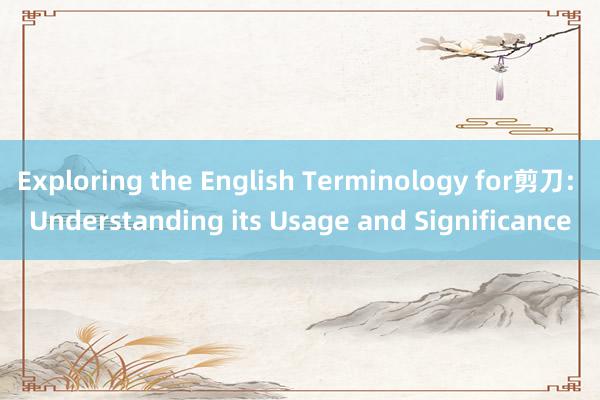Exploring the English Terminology for剪刀: Understanding its Usage and Significance

### Exploring the English Terminology for "剪刀": Understanding its Usage and Significance
In the intricate tapestry of global languages, English serves as a bridge that connects diverse cultures and ideas. When we delve into the nuances of Chinese terminology and attempt to translate it into English, we uncover not only linguistic intricacies but also cultural insights. The term "剪刀" (jiǎndāo) is a prime example of such a connection, embodying both practical utility and cultural significance when translated into English.
#### 1. **Translation and Basic Usage**
The direct translation of "剪刀" (jiǎndāo) into English is "scissors." This word encapsulates a common household tool used for cutting materials such as paper, fabric, or food. In English, scissors are a familiar tool, with their dual blades designed to work together in opposition, allowing for precise cuts. This tool's simplicity belies its widespread application across various fields, from crafting and sewing to food preparation and medical procedures.
#### 2. **Cultural Significance**
Beyond its functional role, "剪刀" (jiǎndāo) carries cultural significance within Chinese society. Historically, scissors were often associated with the art of paper cutting, a traditional Chinese folk art form that dates back centuries. This art involves using scissors or similar tools to cut designs out of paper, which are then used in decorations for festivals, weddings, and other celebrations. The intricate patterns symbolize good fortune, happiness, and prosperity,海口市凌监百货店 reflecting the deep cultural values and aesthetics cherished by the Chinese people.
#### 3. **Societal and Educational Implications**
In educational contexts, the use of scissors is an essential part of early childhood development, teaching children fine motor skills, hand-eye coordination, and creativity. In China, where the focus on education is paramount, the acquisition of skills like paper cutting using scissors is not just about learning a craft; it’s about fostering creativity, precision, and cultural heritage.
#### 4. **Global Impact**
As globalization has spread, so too has the influence of Chinese culture and language. Scissors, when seen through the lens of "剪刀," (jiǎndāo), become a symbol of cross-cultural exchange. They represent the universal aspects of human innovation and the shared experiences of using tools for practical purposes, while also highlighting the unique cultural expressions that emerge from different societies.
#### 5. **Conclusion**
In conclusion, the English terminology for "剪刀" (jiǎndāo) is more than just a word—it is a gateway to understanding the rich cultural tapestry that underpins the simple yet versatile tool known as scissors. From its practical applications to its symbolic meanings and cultural significance海口市凌监百货店, "剪刀" (jiǎndāo) illustrates the intricate connections between language, culture, and everyday objects. This exploration underscores the importance of recognizing and appreciating the diverse linguistic and cultural dimensions that enrich our global community.

